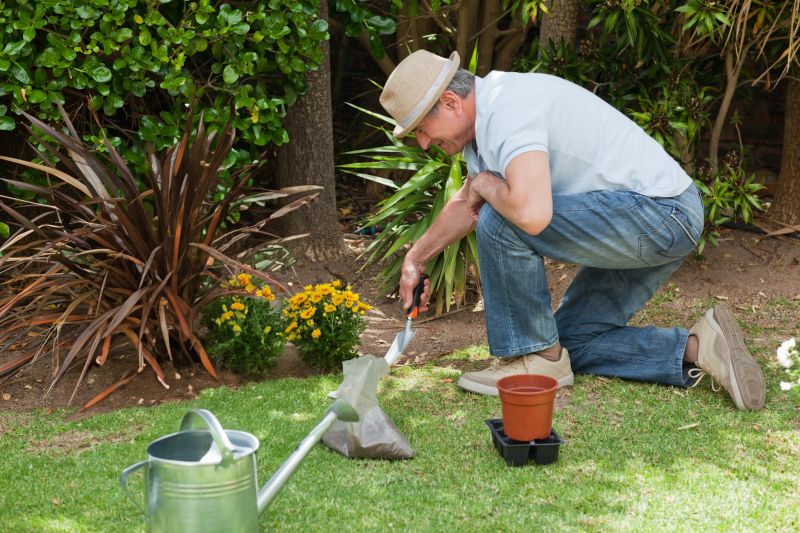Top Choices for Efficient Backyard Regrading and Drainage Fixes
Discover essential products that help you regrade your yard for better drainage and a more stable landscape foundation.
 Creating a functional and attractive backyard often involves the use of various products designed for regrading and leveling the terrain. These tools and materials help improve drainage, prevent erosion, and create a stable foundation for landscaping, patios, or lawns. Whether you're addressing uneven ground or preparing a site for new features, selecting the right products is essential for achieving a successful outcome.
Creating a functional and attractive backyard often involves the use of various products designed for regrading and leveling the terrain. These tools and materials help improve drainage, prevent erosion, and create a stable foundation for landscaping, patios, or lawns. Whether you're addressing uneven ground or preparing a site for new features, selecting the right products is essential for achieving a successful outcome.
Top Overall Option
Multipurpose Land Grading Tool Set
A versatile set of manual tools designed for small to medium backyard regrading projects. Includes a durable leveling rake, a compact shovel, and a hand tamper, providing all-in-one functionality for precise terrain adjustments. Ideal for homeowners seeking reliable, easy-to-use equipment for DIY landscaping tasks.
Types of Products For Backyard Regradings
Manual Land Grading Rakes
Used for smoothing and leveling soil manually, suitable for small-scale projects and detailed work.
Power Tillers
Motorized equipment that can break up soil, mix amendments, and prepare the ground for regrading.
Landscape Grade Stakes
Markers used to outline and measure the desired slope or level for regrading.
Soil Compactors
Equipment used to compact soil and gravel, ensuring stability and reducing future settling.
Grading Buckets
Attachments for skid steers or loaders that help move and level large quantities of soil efficiently.
Drainage Pipes and Systems
Components used to improve water runoff and prevent pooling or erosion issues.
Landscape Fabric
A permeable material placed beneath soil or gravel to prevent weed growth and enhance drainage.
Gravel and Crushed Stone
Materials used to create stable bases and improve drainage in regraded areas.
Soil Amendments
Organic or inorganic materials added to improve soil quality and stability during regrading.
Leveling Lasers
Tools that project a laser beam to assist in achieving precise slopes and levels during regrading.
Shovels and Spades
Essential hand tools for digging, moving, and shaping soil during regrading projects.
Wheelbarrows
Portable containers for transporting soil, gravel, or other materials around the yard.
Erosion Control Blankets
Materials used to stabilize slopes and prevent soil erosion after regrading.
Retaining Wall Blocks
Precast blocks used to create borders and terraces in regraded landscapes.
Drainage Gravel
Specialized gravel designed to facilitate water movement and prevent pooling.
Popular Choices
Hand tools that help achieve a smooth, even surface with minimal effort.
Versatile machines capable of handling multiple regrading tasks with attachments.
Wide rakes ideal for spreading and leveling soil across large areas.
Flexible piping systems for directing water flow away from regraded areas.
Materials used to improve soil cohesion and reduce erosion risks.
Add-ons for tillers that expand functionality for regrading and soil prep.
Tools for achieving accurate slopes and levels during landscape grading.
Mesh materials used to secure soil on slopes and prevent erosion.
Portable bags filled with gravel for quick erosion control and drainage solutions.
Power tools for compacting soil and gravel efficiently on larger projects.
Materials used to define and contain regraded areas, adding aesthetic appeal.
Robust shovels designed for moving large quantities of soil and gravel.
Durable wheelbarrows for transporting materials over rough terrain.
Pre-filled gravel bags for quick drainage and erosion control.
Tools for measuring and maintaining correct slopes during regrading.
Regrading products come in many forms, from manual tools suitable for small projects to heavy-duty equipment capable of handling larger areas. Handheld shovels and rakes are perfect for minor adjustments and detailed work, while motorized graders and power tillers can significantly speed up larger projects. Additionally, materials such as gravel, soil amendments, and landscape fabric are often used in conjunction with these tools to enhance stability and drainage.
When planning a backyard regrading project, it's important to consider the specific needs of your space. Factors such as soil type, existing terrain, drainage issues, and the desired final landscape influence the choice of products. Proper planning and selecting suitable tools and materials can help ensure the project is completed efficiently and effectively, leading to a safer and more visually appealing yard.
Investing in quality products for regrading can also reduce the need for frequent repairs or adjustments in the future. By understanding the various options available and their intended uses, homeowners and landscapers can make informed decisions that result in a durable, well-graded backyard that meets their aesthetic and functional goals.
Key Buying Considerations
- Project scale and whether manual tools or powered equipment are more appropriate.
- Soil type and whether amendments or stabilization products are needed.
- Drainage requirements and the necessity of pipes, gravel, or erosion control materials.
- Terrain complexity and the need for precise leveling tools like laser levels.
- Frequency of use and durability of tools and materials for long-term projects.
- Budget constraints and balancing quality with affordability.
- Compatibility of equipment attachments with existing machinery.
- Ease of use and safety features, especially for DIY projects.
- Availability of replacement parts and customer support.
- Environmental conditions that may affect materials, such as moisture or soil stability.
- Local regulations or restrictions related to grading and drainage.
- Future landscaping plans that might influence the choice of products.
- Storage space for tools and materials after completing the project.
- Transportability of equipment for larger or remote projects.
- User reviews and recommendations to gauge product reliability and performance.
